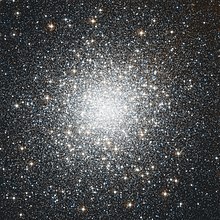
Back عنقود كروي Arabic Cúmulu globular AST Kürəvi ulduz topaları Azerbaijani Шаравое зорнае скопішча Byelorussian Кълбовиден звезден куп Bulgarian বর্তুলাকার স্তবক Bengali/Bangla Kuglasto zvjezdano jato BS Cúmul globular Catalan Kulová hvězdokupa Czech Kuglehob Danish
| Globular cluster | |
|---|---|
 | |
| Characteristics | |
| Type | Star cluster |
| Mass range | 1K M☉ - >1M M☉[1] |
| Size range | 10-300 ly across[1] |
| Density | ~2 stars/cubic ly [1] |
| Average luminosity | ~25 000 L☉[1] |
| External links | |
| Additional Information | |
| Discovered | Abraham Ihle, 1665 |
A globular cluster is a spheroidal conglomeration of stars that is bound together by gravity, with a higher concentration of stars towards its center. It can contain anywhere from tens of thousands to many millions of member stars,[2] all orbiting in a stable, compact formation. Globular clusters are similar in form to dwarf spheroidal galaxies, and though globular clusters were long held to be the more luminous of the two, discoveries of outliers had made the distinction between the two less clear by the early 21st century.[3] Their name is derived from Latin globulus (small sphere). Globular clusters are occasionally known simply as "globulars".
Although one globular cluster, Omega Centauri, was observed in antiquity and long thought to be a star, recognition of the clusters' true nature came with the advent of telescopes in the 17th century. In early telescopic observations, globular clusters appeared as fuzzy blobs, leading French astronomer Charles Messier to include many of them in his catalog of astronomical objects that he thought could be mistaken for comets. Using larger telescopes, 18th-century astronomers recognized that globular clusters are groups of many individual stars. Early in the 20th century the distribution of globular clusters in the sky was some of the first evidence that the Sun is far from the center of the Milky Way.
Globular clusters are found in nearly all galaxies. In spiral galaxies like the Milky Way, they are mostly found in the outer spheroidal part of the galaxy – the galactic halo. They are the largest and most massive type of star cluster, tending to be older, denser, and composed of lower abundances of heavy elements than open clusters, which are generally found in the disks of spiral galaxies. The Milky Way has more than 150 known globulars, and there may be many more.
Both the origin of globular clusters and their role in galactic evolution are unclear. Some are among the oldest objects in their galaxies and even the universe, constraining estimates of the universe's age. Star clusters were formerly thought to consist of stars that all formed at the same time from one star-forming nebula, but nearly all globular clusters contain stars that formed at different times, or that have differing compositions. Some clusters may have had multiple episodes of star formation, and some may be remnants of smaller galaxies captured by larger galaxies.
- ^ a b c d "Globular cluster - Colour-magnitude diagrams | Britannica". www.britannica.com. Retrieved March 11, 2023.
- ^ "Globular cluster". ESA/Hubble. Retrieved July 4, 2022.
- ^ Van Den Bergh, Sidney (March 2008). "Globular clusters and dwarf spheroidal galaxies". Monthly Notices of the Royal Astronomical Society: Letters. 385 (1): L20 – L22. arXiv:0711.4795. Bibcode:2008MNRAS.385L..20V. doi:10.1111/j.1745-3933.2008.00424.x.